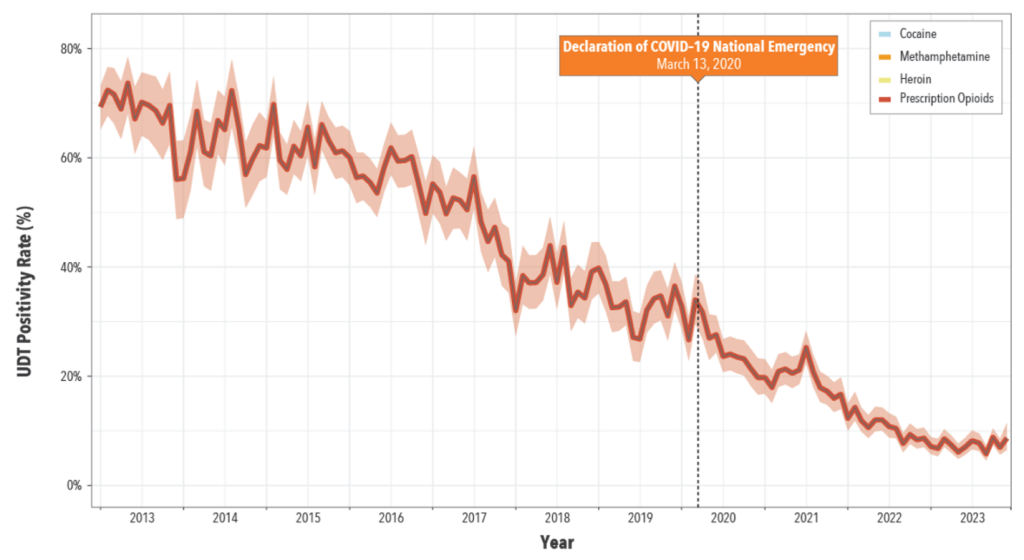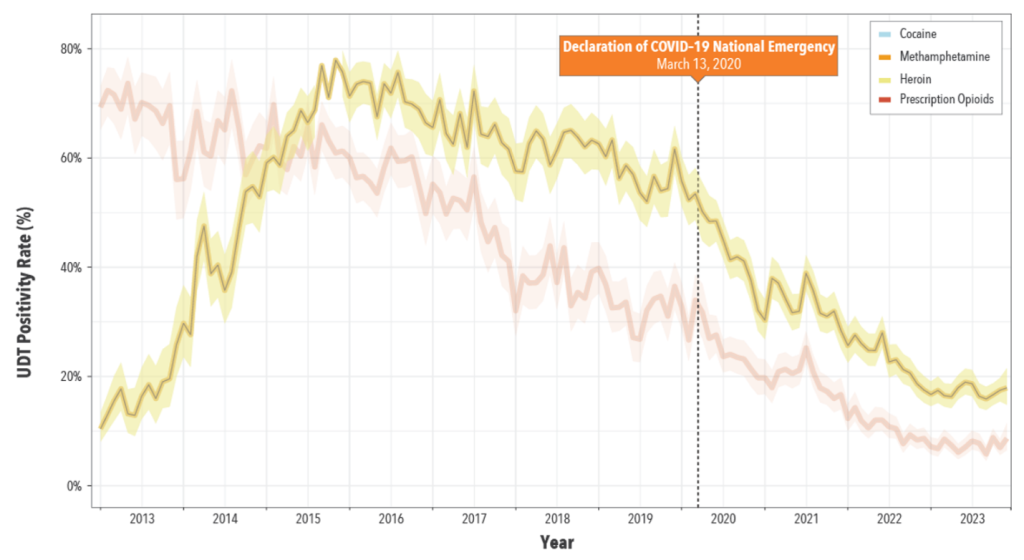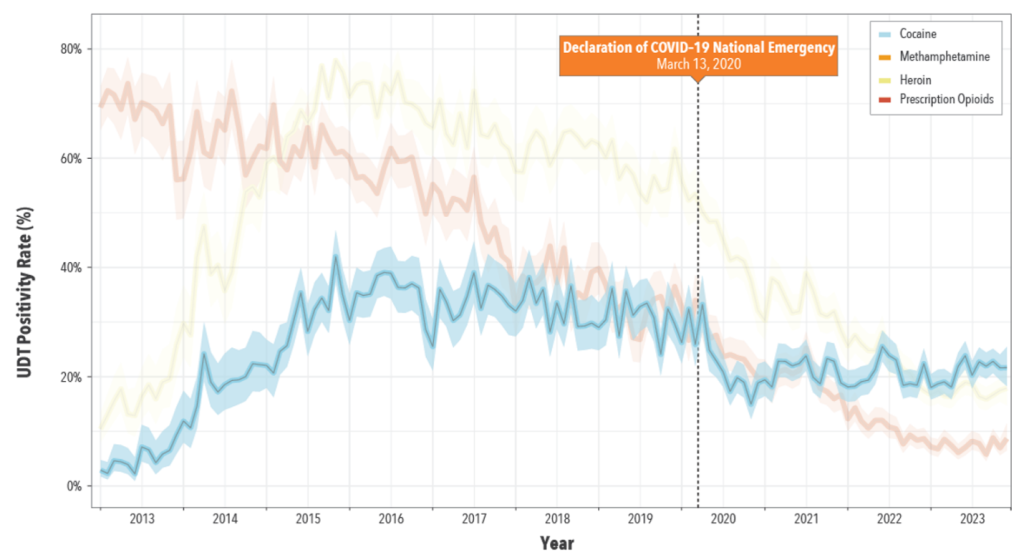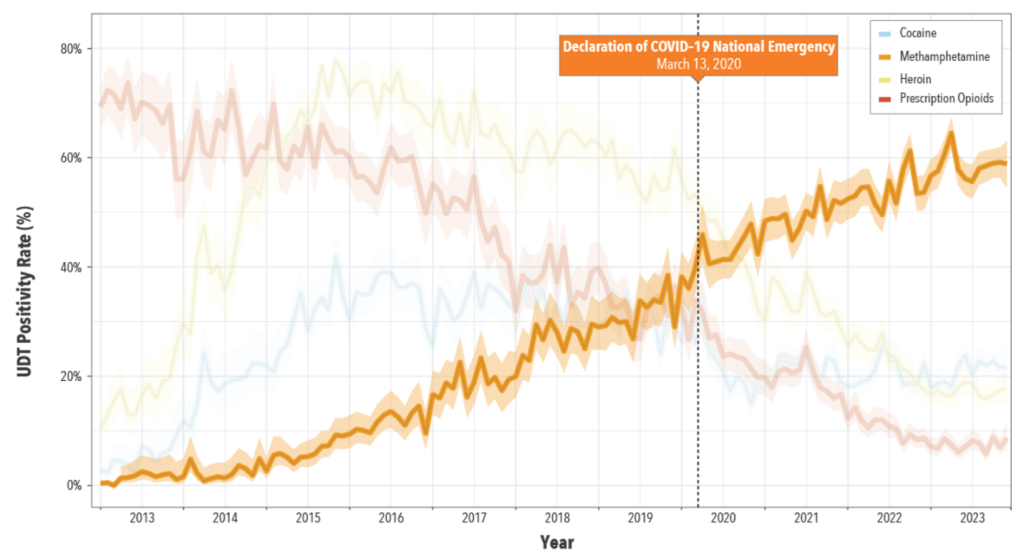Millennium Health Signals Report Identifies A New Threat: More People Who Use Fentanyl Are Also Using Stimulants Now

This blog was written by our colleague Eric Dawson, PharmD. He’s the Vice President of Clinical Affairs at Millennium Health. Dr. Dawson is keenly aware of the issues of drug misuse and addiction. He is passionate about educating clinicians on the topic and has given many lectures to pharmacists, nurses, and physicians.
In 2023, for the first time, methamphetamine and cocaine were detected in fentanyl-positive urine drug test (UDT) specimens more often than heroin and prescription opioids nationally and in nearly every state.
This finding is from the most recent Millennium Health Signals Report™ which explored national trends in prescription opioid, heroin, methamphetamine, and cocaine use among people who tested positive for fentanyl from 2013 to 2023.
In other words, we started with those using fentanyl and then looked within that group to see how drug use trends have changed over time at the national level. The figure shows what percentage of those using fentanyl were also positive for a given drug or drug class. Importantly—to better study non-prescribed and/or illicit use of these drugs—we removed data for anyone who was prescribed any of the drugs we analyzed.
First, as shown in Figure 1 below, prescription opioid use was very common among people who were using fentanyl in 2013; prescription opioids were detected in 68% of fentanyl-positive urine specimens that year. Since then, prescription opioid use in this group has steadily declined and reached an historic low in 2023, down 89% since 2013.

Figure 1: UDT positivity rates for prescription opioids in the population using fentanyl
Second, Figure 2 shows that heroin use among those using fentanyl peaked at 71% in 2016. It then fell by 75% through 2023—returning to near 2013 levels—with heroin being detected in 17% of fentanyl-positive specimens in 2023.

Figure 2: UDT positivity rates for heroin in the population using fentanyl
Third, as shown in Figure 3, trends in cocaine use among people using fentanyl have been a bit more variable. Cocaine use in this group has fluctuated over time but is up 318% since 2013. In 2023, cocaine was the second most detected drug in this group.

Figure 3: UDT positivity rates for cocaine in the population using fentanyl
Lastly, Figure 4 shows that the most striking and concerning changes we have observed are for methamphetamine. Our data show that methamphetamine use has progressively increased among people who use fentanyl since 2013 and has grown by 875% since 2015 alone. In 2023, methamphetamine was detected in 60% of fentanyl-positive specimens nationally, making it the most common drug found alongside fentanyl in our database.

Figure 4: UDT positivity rates for methamphetamine in the population using fentanyl
These national trends provide insight into the broad shifts in drug use. However, we know that the illicit drug supply and drug use trends can vary considerably depending on where you look. So, let’s look at what has happened at the state level.
Figures 5 through 10 show hex maps of the U.S., where the fill color of each state indicates which of the four drugs or drug classes studied was most found alongside fentanyl during the year shown.

Figure 5: In 2013, prescription opioids were detected most frequently in fentanyl-positive specimens in all states. Unfilled hexagons represent states without fentanyl-positive specimens that had ordered UDT results for all four drugs or drug classes of interest.

Figure 6: Heroin detection in fentanyl-positive specimens starts to appear on the map in 2015 in portions of the East and Midwest and then continued to spread South and West over the next few years.

Figures 7: Heroin detection in fentanyl-positive specimens topped the list in most states in 2017.

Figure 8: Heroin was detected most frequently in fentanyl-positive specimens in most states in 2019.

Figure 9: Between 2019 and 2021, a dramatic shift occurred—cocaine and methamphetamine in blue and orange, respectively, were most commonly found alongside fentanyl in more states than heroin and prescription opioids combined.

Figure 10: By 2023, methamphetamine had become the most detected drug in fentanyl-positive specimens, followed by cocaine.
In 2023, methamphetamine tends to be most commonly found alongside fentanyl in the West and portions of the Midwest and South, while cocaine tends to be more commonly detected in people who use fentanyl primarily in the eastern third of the U.S.
Collectively, these UDT data suggest that people who use fentanyl are now, intentionally or unintentionally, much more likely to be using methamphetamine and cocaine as well. Importantly, which of these two stimulants is most commonly used by people who use fentanyl varies depending on where they live.
The lack of FDA-approved medications for stimulant overdose and the treatment of stimulant use disorders limits the clinical tools that are available and increases the complexity and intensiveness of treatment regimens for those with co-occurring opioid and stimulant use disorders, as well as those with a primary stimulant use disorder.
Recent Posts
Rely on Kipu to keep you ahead of change.
Subscribe to Kipu for behavioral health news, updates, community celebration, and product announcements.


